Red Ring
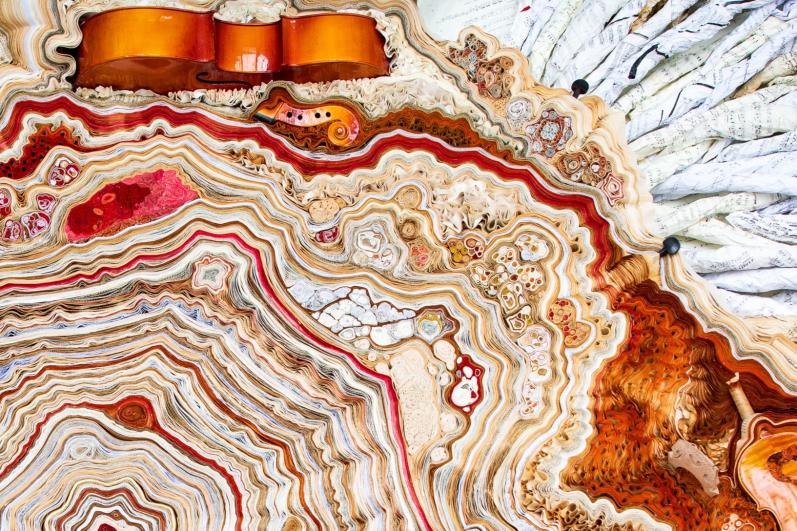 © Fatima Jellaoui
© Fatima Jellaoui
The five rings of the piece echo the symbolism of the Olympic rings, i.e. the union of all the continents.
Blending paper and the wood of the bowed strings, the red ring is a naturalistic evocation of a growth ring, visible on the cross-section of a tree trunk.
Inspired by the red earth of Oklahoma, the home State of Rachel Marks, the red ring is the first to be created. Associated with the bowed string family of instruments, it is organically designed, reproducing the concentric circles characteristic of a tree cut.
The presence of parts of string quartet instruments, made of spruce, maple or ebony, reinforces the natural link between the work's constituent materials, namely, the paper and wood pulp used to make it. This connection is present throughout Rachel Marks' work.
Yellow Ring
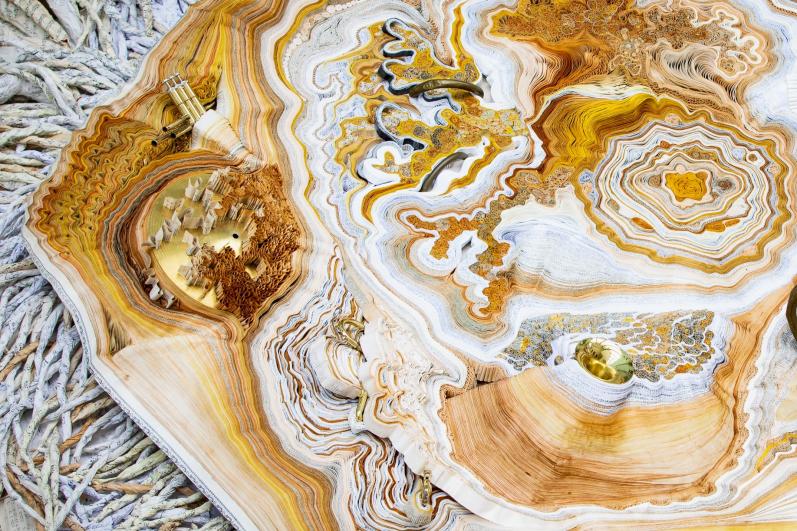 © Fatima Jellaoui
© Fatima Jellaoui
The yellow ring is associated with the brass family of instruments. Rachel Marks describes this ring as the most spontaneous in her installation, conceived intuitively, without any prior sketches.
Inspired by the volcanic landscapes of Japan, the work is an emergence, assembled without prior sketch, in the manner of a jazz musical improvisation.
Rachel Marks develops several motifs in this ring: scrolls, flames, arcs and undulations. They pay tribute to the traditional motifs of Japan, where the artist spent a residency. Symfolia, like much of Rachel Marks' work, is inspired by the practice of shinrin-yoku (or “forest bathing” in Japanese), which is said to have beneficial effects on body and mind.
Black ring
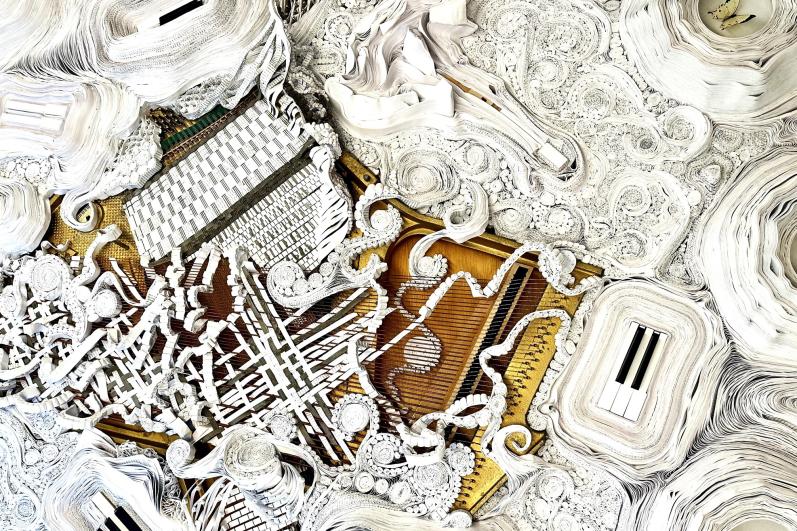 © Fatima Jellaoui
© Fatima Jellaoui
Known as the “black ring” because of the piano keys that stand out against the white paper, it represents the family of keyboard instruments. Conceptualized around the notion of cycle, it is the most geometric of the five rings.
The butterflies in this ring represent the successive phases of the Moon, as well as the cyclical sequence of musical notes in a scale.
The weaving in the piano is a tribute to the art of the Kuba, the Bantu-speaking people of Central Africa, whose process of preparing and dyeing natural fibers, particularly with ash, inspired Rachel Marks to design and create this ring.
Visually, it's the most graphic and symmetrical. It's the white space between the black ink of the words that shines through this ring. Rachel Marks cites John Cage's notion of silence, the potentiality of sound, which gives the audience the possibility of becoming a performer.
Green ring
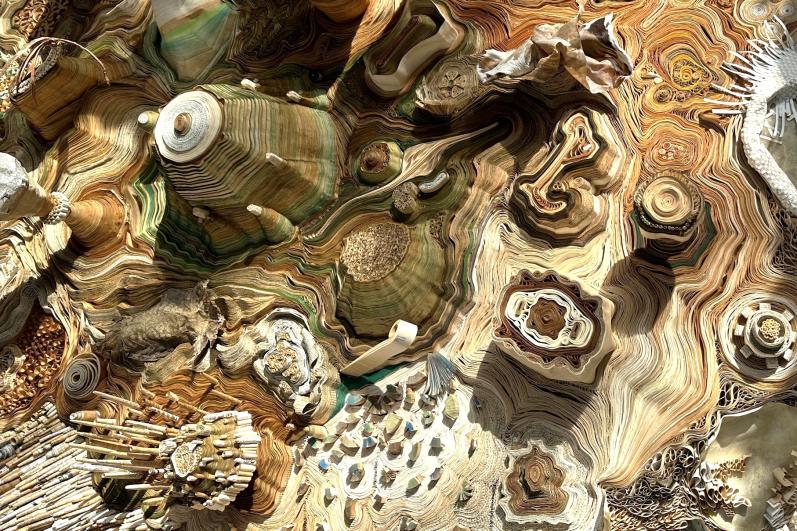 © Fatima Jellaoui
© Fatima Jellaoui
The green ring represents the membranophone family of instruments. By breaking away from the more realistic model of the first three rings, this work takes on a new dimension in space.
A membranophone is a percussion instrument whose sounds are produced by the vibration of a membrane stretched over a frame. Drumheads are used here to evoke their animal origins. The percussion also echoes the primordial rhythm of a beating heart. Rachel Marks conceived the work on this ring around the link between this type of percussion and the use of parchment as a writing medium before paper was invented.
The different heights in this ring evoke for the artist the spectacular rock formations of Australia.
Blue ring
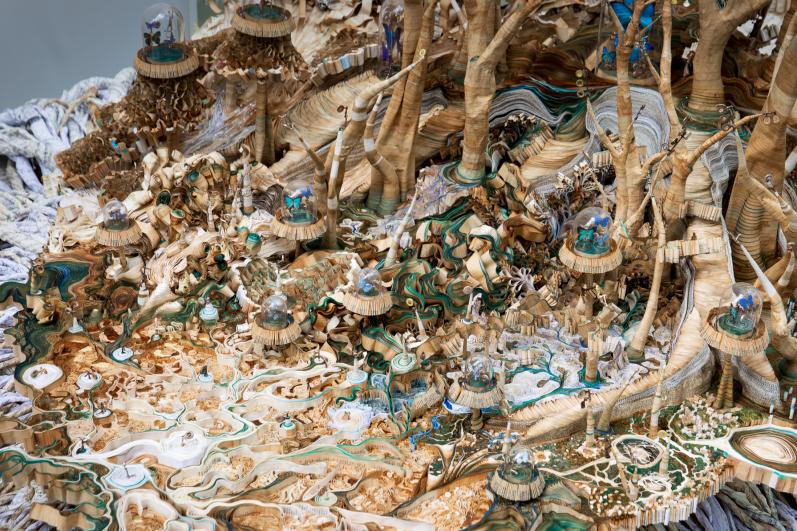 © Fatima Jellaoui
© Fatima Jellaoui
The blue ring evokes the woodwind family represented by the flute. This fifth and final ring is conceived as a self-portrait of the artist and the collective experience of her residency at the Philharmonie de Paris.
This ring is a tribute to the flute, an instrument played by Rachel Marks. Inspired by Europe, the artist's adopted continent where her creativity flourished, the work seems to spring from the severed surface of a trunk. The pieces of flute are like young tree shoots in full bloom.
The mechanics of the flutes (keys, valves and plates) are replaced here by mycelium made of paper. In nature, these filaments, which form the underground part of fungi, enter into symbiosis with certain plants, stimulating their growth. This motif, present throughout the ring, evokes the symbolic association of those who have joined forces to create Symfolia.